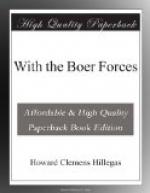The most conspicuous feature of the Boer forces was the equality of the officers and the men, and the entire absence of any assumption of superiority by the leaders of the burghers. None of the generals or commandants wore any uniform of a distinctive type, and it was one of the most difficult problems to distinguish an officer from the burghers. All the officers, from the Commandant-General down to the corporal, carried rifles and bandoliers, and all wore the ordinary garb of a civilian, so that there was nothing to indicate the man’s military standing. The officers associated with their men every hour of the day, and, in most instances, were able to call the majority of them by their Christian names. With one or two exceptions, all the generals were farmers before the war started, and consequently they were unable to assume any great degree of superiority over their farmer-burghers if they had wished to do so. General Meyer pitched quoits with his men, General Botha swapped tobacco with any one of his burghers, and General Smuts and one of his officers held the whist championship of their laager. Rarely a burgher touched his hat before speaking to an officer, but he invariably shook hands with him at meeting and parting. It is a Boer custom to shake hands with friends or strangers, and whenever a general visited a laager adjoining his own, the hand-shaking reminded one of the President’s public reception days at Washington. When General Joubert went from camp to camp he greeted all the burghers who came near him with a grasp of the hand, and it was the same with all the other generals and officers. Whenever Presidents Kruger and Steyn went to the commandos, they held out their right hands to all the burghers who approached them, and one might have imagined that every Boer was personally acquainted with every other one in the republics. It was the same with strangers who visited the laagers, and many a sore wrist testified to the Boer’s republicanism. Some one called it the “hand-shaking army,” and it was a most descriptive title. Many of the burghers could not restrain from exercising their habit, and shook hands with British prisoners, much to the astonishment of the captured.
Another striking feature of life in the Boer laagers was the deep religious feeling which manifested itself in a thousand different ways. It is an easy matter for an irreligious person to scoff at men who pass through a campaign with prayer and hymn-singing, and it is just as easy to laugh at the man who reads his Testament at intervals of shooting at the enemy. The Boer was a religious man always, and when he went to war he placed as much faith in prayer and in his Testament as in his rifle. He believed that his cause was just, and that the Lord would favour those fighting for a righteous cause in a righteous spirit. On October 11th, before the burghers crossed the frontier at Laing’s Nek, a religious service was conducted. Every burgher in the commandos knelt on the ground




